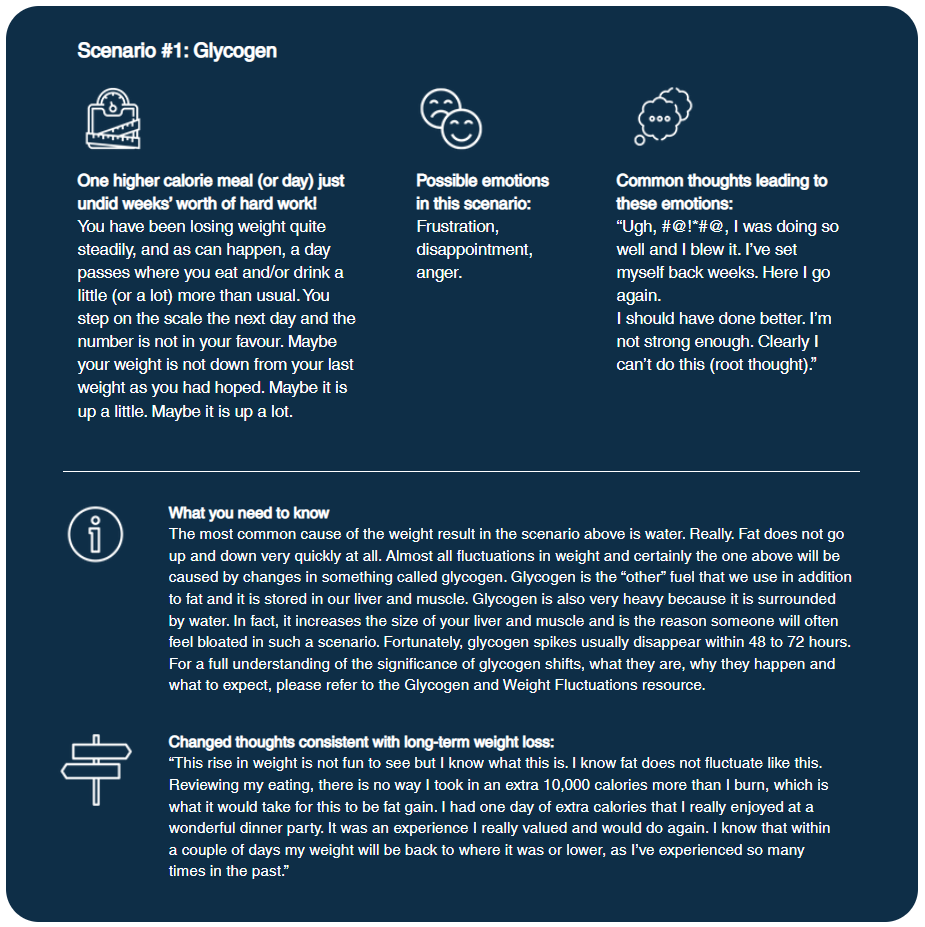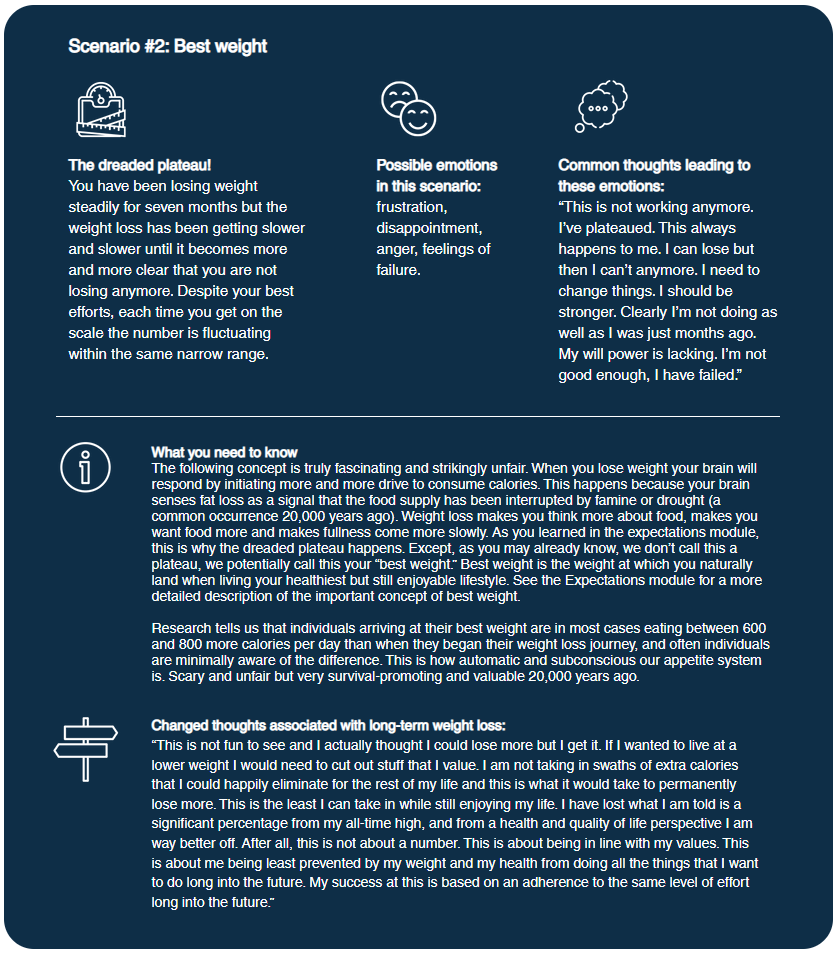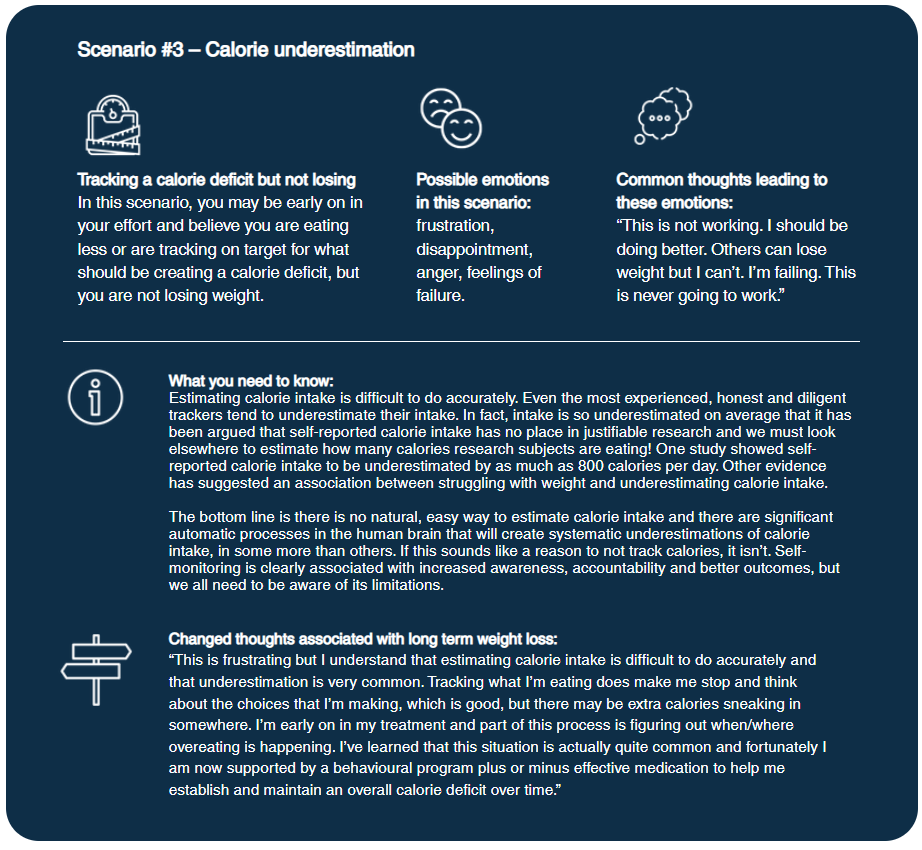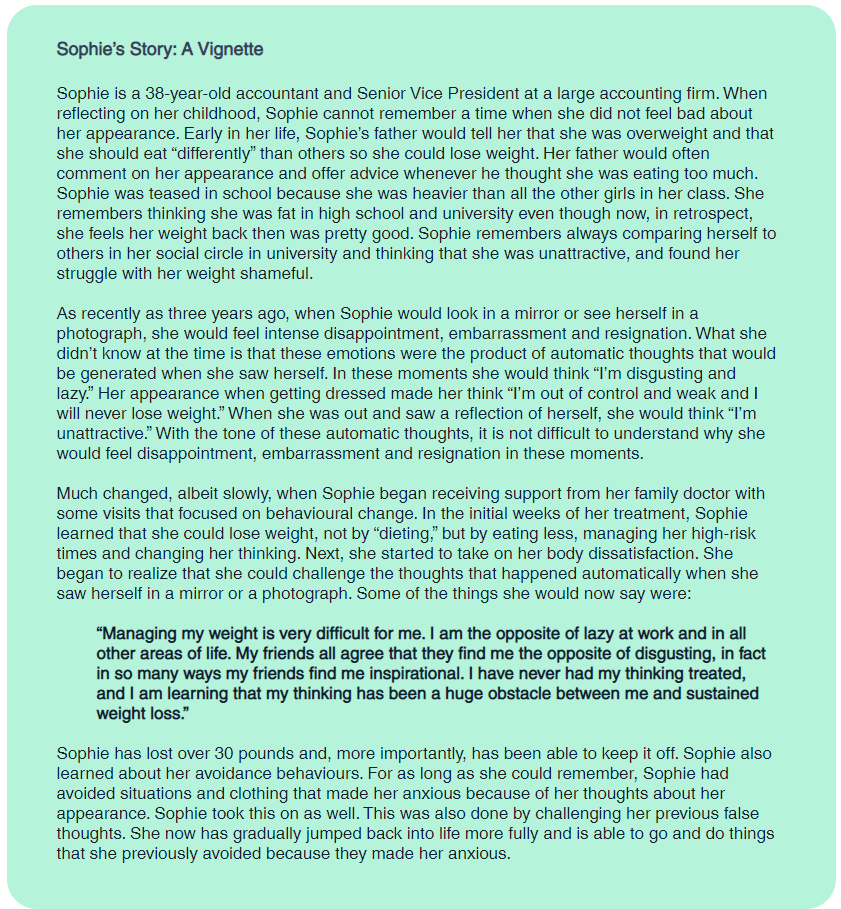In this final module, you will be asked to consider that SETBACKS are a natural consequence of any weight management effort and that success is determined not by whether or not you experience SETBACKS but by how you respond to them. This is the principle of resilience. Here you will be invited in a formal way to work on resilience.
Process
The process of resilience skill development is:
1. Recognizing the thoughts and emotions that automatically arrive in the aftermath of a SETBACK; thoughts that speak poorly about you and your ability to manage your weight.
2. Learning to challenge these thoughts is the process of generating resilience. You will discover how changing your thinking will help you recover from SETBACKS and maintain your motivation to adhere to your weight management efforts.
You may remember from earlier that adherence—the degree to which participants are able to maintain the changes they have made—is most strongly associated with weight loss and improved health. Resilience is a key skill in determining adherence. Again, like WANTING and restraint, the capacity to practice resilience is considered a variable trait and is highly heritable.
Another way to think of this is that SETBACKS can negatively affect adherence. The following are three common SETBACKS. When you read them, try to picture yourself in the immediate aftermath of each one, and imagine how you feel.
In the restraint module, you were invited to discover, challenge and ultimately change autopilot thoughts, also called ‘permission thoughts.’ In this module you will see an exact parallel. You will be invited to discover, challenge and ultimately change another set of automatic thoughts.
Remember that we have two thinking systems: one that is fast and automatic, and a second that is slow, deliberate and forward thinking. Here, the fast thinking Autopilot generates thoughts that come when you are in the aftermath of a SETBACK. Where do these thoughts come from? Why are they there?
These thoughts are the product of your past weight loss efforts (if you have not tried to lose weight in the past, these may not be present and may not be an obstacle). If past weight loss efforts have been challenging or numerous it is quite likely that you have developed a library of automatic thoughts that:
-
Speak poorly about you as a person
-
Speak poorly about your capacity to succeed in managing your weight
These negative thoughts use your past weight loss efforts and failures as evidence against you. The predominance of these thoughts will also be the consequence of genetics, the presence of depression or anxiety, and even of childhood experiences. In what follows you will learn the proven method of developing and strengthening resilience.

Three-step process for resilience
Resilience is built using cognitive-behavioural therapy (CBT). The actual tool of CBT is called cognitive restructuring; literally changing one’s thinking.
The first step in the cognitive restructuring process is discovering your automatic post-SETBACK thinking.
The second step is challenging those thoughts with evidence,
The third step is creating new resilience thoughts based on your evidence.
With practice, these new resilience thoughts may become the new response to SETBACKS, displacing negative thinking.
Let’s explore these steps in more detail.

Thinking unique to an overeating or overdrinking episode
STEP 1: Discovering self-critical thoughts
Capturing self-critical thoughts sounds easy enough but in fact, learned self-critical thoughts, as discussed earlier, are automatic and fleeting and often go unnoticed.
Self-critical thoughts have unique characteristics.
✅ They immediately follow SETBACKS
✅ They are automatic, not controllable.
✅ They will speak poorly about you as a person and your ability to sustainably lose weight.
The following are examples of what self-critical thoughts may sound like. Identifying self-critical thinking looks like a funnel.
At the top are a bunch of thoughts becoming less and less as you get lower, and as little as one root thought at the bottom.
At the top, in the aftermath of a SETBACK you may hear:
“I should not have done that.”
“What was I thinking?”
So what does that say about you?
It says I am weak—I should be stronger
It says I don’t have enough willpower
It says even when I do well, eventually I mess up
It says even when I try hard, this does not work
What does this say about the likelihood of succeeding long term?
It says I can’t; It says I won’t succeed; It says this is too hard, and I can’t do this (root thought).
This last thought at the bottom of the funnel is called a root thought. In the aftermath of SETBACKS this is an exceedingly common root thought.

STEP 2: Where is the evidence?
Fortunately this second step in resilience development is not necessarily easy but is certainly very straightforward.
Ultimately you may realize that the evidence you hold that supports your thinking and your root thought is based on your past weight loss experiences and failures. So, for a moment think about your past weight loss efforts.
In the past when you were provided an ethical, comprehensive and effective behavioural weight management program over a long period of time by trained health care professionals, potentially combined with effective and safe medication… how did it go?
It is very likely that your answer to this question will be, “I have never experienced that before.” But you see the bolded question above is the actual treatment for the real medical condition you live with.
If you have never been comprehensively and effectively treated for the real condition you live with, this brings up a very important question!
Is it possible that your past weight loss efforts are inadmissible evidence as to whether you can effectively and sustainability lose weight? Can you challenge the thoughts and root thought above based on the fact that you have never been effectively treated in the past?

STEP 3: Creating new resilience thoughts
This last step sets you up for thinking differently in moments of SETBACK. In place of self-critical thoughts, could you see yourself thinking differently? Could SETBACKS be followed by thoughts such as these?
“I can view this as a reminder that this is difficult and that SETBACKS are inevitable. I know that how I do long term will not be determined by my SETBACKS but by how I respond to them. I know the automatic thought in this moment revolves around me not being able to succeed, but I also know that thought is based on my past. I have never been supported with a comprehensive behavioural treatment. I have never in the past been properly supported by safe and effective medication.”
As confidence builds you may encounter thoughts in these moments that sound like:
“I know what I am capable of. I know when I do it, it works. I know what to do and I know how to do it. I know the pathway that works for me and is still very enjoyable and at a level of effort that is sustainable. Let me roll up my sleeves and try to understand why this SETBACK happened. Let me get support.”

From demotivation to motivation: all about the emotions
There is a truism in psychology that thoughts lead to emotions that lead to behaviour. If unchallenged, the original self-critical automatic thoughts generate emotions such as frustration, disappointment, anger, sadness and feelings of failure. These emotions ultimately lead to demotivation and a single SETBACK can set you up for more SETBACKS and an unfortunate demotivational cycle can begin.
Put simply, by identifying, challenging and replacing the automatic thinking, SETBACKS may become a source of motivation and a golden opportunity toward learning and progress and ultimately success.
There are many aspects of weight management that you do not have control over, such as genetics, your upbringing and conditioning around food, the overall food environment that surrounds you, and how strongly your brain defends against weight loss. Having said this, resilience development is a skill that you can roll up your sleeves for and work on. You may not be able to control whether or not SETBACKS happen on your path to your best weight, but to a significant degree you can control how you respond to them. The skill of resilience can be developed progressively and the consequence is adherence, the key predictor of long-term success.

Thinking unique to the scale SETBACK
Here are some common scenarios related to the scale that can generate negative thinking and emotions and demotivation.



Thinking unique to the body image SETBACK
You have now learned that the aftermath of an off-track eating or drinking day or the aftermath of seeing a number on the a scale that is not in your favour can initiate automatic processes that lead to negative thinking, negative emotions and demotivation.
A third event that can ultimately result in demotivation is exposure to your own image.

In this scenario, we discuss the thoughts, emotions and possible demotivation that can be the consequences of:
1. Seeing yourself in a mirror or reflection
2. Seeing yourself in a photograph
First, a little background on the subject of body dissatisfaction The most common reasons given for wanting to lose weight are related to appearance, satisfaction with looks and attractiveness. You may be surprised to learn that weight loss is generally an ineffective way to accomplish increased satisfaction with how you look. It is extremely common that someone will lose weight and still feel dissatisfaction with their appearance. Body dissatisfaction, if present, is something that you may work on improving in parallel or independent of your body weight.
Body satisfaction, again, like so many other weight-related factors, is about your thinking. Those who feel better about how they look, change the way they think about their bodies. By changing the way you think about your body, you can improve how you feel about yourself.
You may find it surprising to know that there is only a weak relationship between body satisfaction and actual appearance. It turns out that what you look like does not always correlate with how you feel about your appearance. This is particularly true when it comes to body weight. Many non-overweight people hate their appearance and many heavy people are content with their appearance and feel attractive.
As the other modules in the Cognitive Restructuring sections discuss, body satisfaction comes down to your thinking. Your dissatisfaction with your body is much less about your body and much more about the thoughts and beliefs you hold about how you look. Throughout your life you have developed thoughts about your appearance that have been created in response to your day-to-day interactions with people and within our culture. Our society is very concerned with physical appearance and overweight is regularly stigmatized. How do you think and feel about your appearance, and how has today’s culture affected your thinking about your own appearance, body shape and size?
Have you ever experienced personal or professional rejection, criticism or teasing based on how you look? What is the earliest life experience you can recall where attention was brought to your appearance, shape or size? Were there times in your life when people around you criticized your appearance, somewhere in your childhood years, in your teenage years or later in life?
The path to body satisfaction involves working on accepting your body even though you recognize that your appearance may be less than perfect. In fact, good body image can be thought of as the result of several things which will be discussed below.
STEP 1: Discovering self-critical thoughts
Are you ready for the hard work of capturing the thoughts that have come to be associated with your appearance? Are you ready to improve how you feel about yourself? Remember that automatic thoughts lead to emotions. Your work starts by asking yourself the following questions:
1. If you look at yourself in a mirror (or imagine yourself in a mirror), what thoughts and emotions can you identify?
2. If you see yourself in a photograph or a reflection, what thoughts and emotions can you identify?
In these moments, might you feel emotions such as shame, embarrassment, disgust and a feeling of failure or hopelessness? Remember that these emotions are a product of your thinking; you may ask yourself what you were just thinking and what may have triggered these thoughts. Automatic thoughts are immediate and they will speak poorly about your image, who you are as a person and your ability to manage your weight.
You may use the recognition of negative emotions as a cue that negative thinking patterns are happening.
The following are examples of what self-critical body image thoughts may sound like. Again, the self-critical thoughts can be looked at as forming a funnel. At the top are a bunch of thoughts that become less and less as you get lower, and then as little as one root thought at the bottom.
At the top: I am too big. I am disgusting. I am unattractive.
So what does that say about you?
It says I should be stronger – I am weak
It says I am undisciplined
It says I don’t have enough willpower
It says I’m a failure
Which says what about the long term?
It says nothing will change and I will always be like this.
STEP 2: Where is the evidence?
Again, this second step, “where is the evidence?” is not easy but certainly very straightforward. In the case of battling body dissatisfaction you have a significant advantage. Intellectually, everyone can imagine that the character of a person, their kindness, their values, their generosity, have nothing to do with the shape of their bodies. You have learned elsewhere that 70% of the shape and size of someone’s body is influenced by genetics and governed by a unique three-layer ancient appetite system. You have learned that although effective treatment exists to support finding one’s best weight, you have likely never received such treatment before.
You also learned to believe your internalized self-critical thoughts early in life because of the societal stigma directed at overweight individuals. Can you challenge these previous thoughts? What if your thoughts about you and your body are different from what others think about you? Imagine if we brought all your close friends together in one room and asked them about you. What if we asked them if they agreed that you were disgusting, weak, undisciplined and a failure? It is very likely that your friends would argue vehemently against this characterization.
Ultimately you can realize that any evidence you hold that supports your current thinking is based on stigmatizing and biased internalized messaging from your past. Furthermore, you have never been comprehensively supported for the real condition you struggle with, yet effective treatments exist.
STEP 3: Creating new resilience thoughts
This last step sees you thinking differently when exposed to your image. In place of the above self-critical thoughts, could you see yourself thinking differently? Could seeing your image be followed by thoughts such as:
“I am on a journey to find my best weight. My struggle is real and I have never been treated before – not once. Who I am as a person is not a product of my shape and size. I do not have to love the way I look but I can certainly challenge the notion that how I look speaks to who I am as a person. I will work in the direction of finding my best weight and I will consider accepting , maybe begrudgingly at first, that my best weight is the best I can do.”




Leave a Reply